Lars, thanks so much for sharing above in post #816 on your work with damping port resonances. The first two paragraphs belong in a speaker design textbook. How often have I read the misinformation that PRs ‘block’ internal box resonances?
Your tuned and damped stubs remind me of those Yamaha uses in the new NS-5000 to better damp back waves off the domes. In their case not so much stubs as tuned pipes connecting the volume ends.
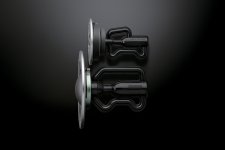
I am really jealous of the NS-5000 design team working inside Yamaha. On Monday someone gets the idea to use tuned pipes for damping. On Tuesday call the guys in the saxophone, trumpet, and French horn division to talk about acoustics in pipes. On Wednesday call the motorsports guys and discuss how they tuned the sound of the YZF-R1 and the V-10 they did for the Lexus LFA.
Your tuned and damped stubs remind me of those Yamaha uses in the new NS-5000 to better damp back waves off the domes. In their case not so much stubs as tuned pipes connecting the volume ends.

I am really jealous of the NS-5000 design team working inside Yamaha. On Monday someone gets the idea to use tuned pipes for damping. On Tuesday call the guys in the saxophone, trumpet, and French horn division to talk about acoustics in pipes. On Wednesday call the motorsports guys and discuss how they tuned the sound of the YZF-R1 and the V-10 they did for the Lexus LFA.
Last edited:
I often add a “stub” in my horn speaker designs while simulating it in Akabak to attenuate a peak. The formula is simple: calculate the 1/4 wave length of the frequency you want to reduce and make a “T” in the flow either through channels in the wooden cabinet or add a PVC pipe. I have seen Darnley use a big 4in PVC pipe stuffed with fiberglass inside one of his tapped horns.
For example, if you have a 300Hz peak you need to attenuate, that’s the same as an 11.2in long stub. Adjust the stuffing to get the level of attenuation you need. The placement of the stub is important and that’s where the simulation can help with optimal placement. You will want to place it where the sound is generated so that it has the most impact. So typically upstream near the driver vs the the horn mouth. For a reflex port probably near the inlet of the port is more effective than the middle.
For example, if you have a 300Hz peak you need to attenuate, that’s the same as an 11.2in long stub. Adjust the stuffing to get the level of attenuation you need. The placement of the stub is important and that’s where the simulation can help with optimal placement. You will want to place it where the sound is generated so that it has the most impact. So typically upstream near the driver vs the the horn mouth. For a reflex port probably near the inlet of the port is more effective than the middle.
Aleksandar Radisavljević aka RAAL did something on that subject in 2017. He incorporated stubs into bookshelf stand. He used really large port diameter to get rid of chuffing but then was left with horrible resonances of such a long pipe. Measurements before and after. Few pics attached:
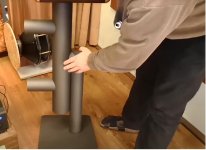

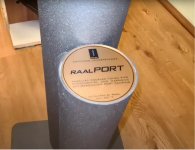
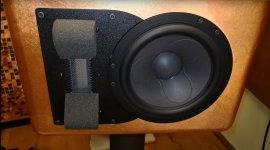

Turquoise - regular pipe
Yellow and red - with acoustic dampers
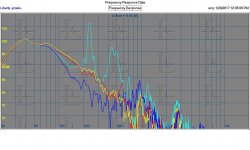
RAAL Advanced Loudspeakers SR-57+Benchmark AHB-2/DAC-3L+CD Transport Zoran Dimovski, 31.03.2018, - YouTube





Turquoise - regular pipe
Yellow and red - with acoustic dampers

RAAL Advanced Loudspeakers SR-57+Benchmark AHB-2/DAC-3L+CD Transport Zoran Dimovski, 31.03.2018, - YouTube
Last edited:
Lars, can you post some pics of the internals of the port and the stuffing? I've been investigating this here and while I can damp resonances successfully, harmonic distortion and chuffing get much worse, much earlier.
Hi Brandon,
Thanks for sharing. The port is simply a 57mm ID tube and the stub is made using a T section without much roundover. The port did not have end flaring so it was whistling loudly when sweepng it witout the stub (air flow exciting the pipe mode) and was silent with the stub. I will do some more measuements on port compression and distrtion next time. The air may hit some of the sharp discontinuities around the T section and make noise. I see that you use some slits and damping material on the outside?
Cheers,
Lars
Lars, can you post some pics of the internals of the port and the stuffing? I've been investigating this here and while I can damp resonances successfully, harmonic distortion and chuffing get much worse, much earlier.
I often add a “stub” in my horn speaker designs while simulating it in Akabak to attenuate a peak. The formula is simple: calculate the 1/4 wave length of the frequency you want to reduce and make a “T” in the flow either through channels in the wooden cabinet or add a PVC pipe. I have seen Darnley use a big 4in PVC pipe stuffed with fiberglass inside one of his tapped horns.
For example, if you have a 300Hz peak you need to attenuate, that’s the same as an 11.2in long stub. Adjust the stuffing to get the level of attenuation you need. The placement of the stub is important and that’s where the simulation can help with optimal placement. You will want to place it where the sound is generated so that it has the most impact. So typically upstream near the driver vs the the horn mouth. For a reflex port probably near the inlet of the port is more effective than the middle.
Thank you, very clever to use in a horn. yes, I also simulate it (Comsol). I found that the stub when filled can be much shorter than a quarter wavelength. I saw that an unfilled quarterwave stub can create a subharmonic mode since there is now a half wavelength path being open in one end and closed in the other end (so resonating at half the frequency).
Placement along the port is also important as you say. A single stub can be placed between half and a quarter length in order to dampen the first two pipe modes. Two stubs could be placed at a quarter and the middle of the port.
Aleksandar Radisavljević aka RAAL did something on that subject in 2017. He incorporated stubs into bookshelf stand. He used really large port diameter to get rid of chuffing but then was left with horrible resonances of such a long pipe. Measurements before and after. Few pics attached:
View attachment 962422 View attachment 962423 View attachment 962424 View attachment 962425 View attachment 962430
Turquoise - regular pipe
Yellow and red - with acoustic dampers
View attachment 962427
RAAL Advanced Loudspeakers SR-57+Benchmark AHB-2/DAC-3L+CD Transport Zoran Dimovski, 31.03.2018, - YouTube
Thank you for sharing! Very clever port design. Looks like 2 shorter and one long stub.
Hi Brandon,
I see that you use some slits and damping material on the outside?
Cheers,
Lars
Yes, wool stuffing in a chamber the taps feed into. I've moved to ever smaller slits hoping to get non-linear performance back up, but no luck. It would make sense that no matter how small the taps, if they are effective at damping the port resonance then there must be air rapidly vibrating or breathing into and out of those taps. This must create turbulence that the rest of the air mass of the port must interact with. I wouldn't think the Polk idea would be any different but they claim it is so I'll test that.
Thank you for sharing! Very clever port design. Looks like 2 shorter and one long stub.
Yes. Two shorter positioned at 1/4 of the port length and one longer positioned at 1/2 of port length.
This stubbed port is not a new idea. There are patents and papers describing it's function. It actually dows work. And is a good application of a resonant supression system.
Would the Purifi be a good candidate for a two-way with a horn-loaded tweeter or compression driver? Get the Purifi alone in it's own vented cabinet, and have the horn tweeter/horn compression driver mounted externally, on top?
I'm thinking of a horn design like those offered by Joesph Crowe or Jean Michel Le Cleach, and an external crossover like Nelson Pass's 6-24.
Thanks for any guidance,
Brad
I'm thinking of a horn design like those offered by Joesph Crowe or Jean Michel Le Cleach, and an external crossover like Nelson Pass's 6-24.
Thanks for any guidance,
Brad
Quote -
“ Would the Purifi be a good candidate for a two-way with a horn-loaded tweeter or compression driver? Get the Purifi alone in it's own vented cabinet, and have the horn tweeter/horn compression driver mounted externally, on top? “
There’s several great dome tweeters 92 - 97 dB - way more than the Purifi
While the Purifi’s sensitivity, perhaps with a little BSC/ warmth added is effectively only ~ 85
especially for the many amongst us who like me, love Class A …
Occasionally I’ve thought how great it would be to have Purifi wooofers, driven by class A
(I know this is pretty much the opposite of Purifi’s approach: compact speakers, yet still quire deep bass, driven by big watts, likely class D. Some of which undoubtedly, excellent)
Class A, yet still want a system capable of peaks on some material or occasions of ? 100 - 105 dB - but not too massive heatsinks/ electricity. However can live with a bigger speaker, potentially much bigger. (And or - less likely - separate subs)
Your suggestion triggered - how well would Purifi respond to horn loading?
Can’t recall the EBP guideline, my hunch is they’re not ideal. Unless ridiculously big, you’d lose a lot of extension, and need subs. (Though there are benefits in separate subs).
That said - does anyone know a ~ rule of thumb dB gain you could achieve?
Two a side in parallel.
… can theoretically gain 6 dB. * If the amp driving it is both -
- ok at the lower ohms. (What would it be with this Purifi ?) 3? ohms.
- AND, actually does double its output into the lower ohms.
(In reality often it might be not the full 6 dB, maybe closer to + 5)
Though - for drivers as good as Purifi
making a really good amp that’s fine tuned to that low ohm load is easier to justify than most amp builds. Good candidates, Class A?
- A variant of an 805 SE? Normally into 8 ohms, is close to 50 watts
- One that’s ~ 40% efficient - the Alpha Nirvana.
Andyr did a “4 ohm variant” with 21 v rails. Outputting 34 watts - into 2.1 ohms. With a careful choice of rail voltage (and later optimising the bias) you could probably get a little more output.
Has anyone used these woofers with tubes or class A?
“ Would the Purifi be a good candidate for a two-way with a horn-loaded tweeter or compression driver? Get the Purifi alone in it's own vented cabinet, and have the horn tweeter/horn compression driver mounted externally, on top? “
There’s several great dome tweeters 92 - 97 dB - way more than the Purifi
While the Purifi’s sensitivity, perhaps with a little BSC/ warmth added is effectively only ~ 85
especially for the many amongst us who like me, love Class A …
Occasionally I’ve thought how great it would be to have Purifi wooofers, driven by class A
(I know this is pretty much the opposite of Purifi’s approach: compact speakers, yet still quire deep bass, driven by big watts, likely class D. Some of which undoubtedly, excellent)
Class A, yet still want a system capable of peaks on some material or occasions of ? 100 - 105 dB - but not too massive heatsinks/ electricity. However can live with a bigger speaker, potentially much bigger. (And or - less likely - separate subs)
Your suggestion triggered - how well would Purifi respond to horn loading?
Can’t recall the EBP guideline, my hunch is they’re not ideal. Unless ridiculously big, you’d lose a lot of extension, and need subs. (Though there are benefits in separate subs).
That said - does anyone know a ~ rule of thumb dB gain you could achieve?
Two a side in parallel.
… can theoretically gain 6 dB. * If the amp driving it is both -
- ok at the lower ohms. (What would it be with this Purifi ?) 3? ohms.
- AND, actually does double its output into the lower ohms.
(In reality often it might be not the full 6 dB, maybe closer to + 5)
Though - for drivers as good as Purifi
making a really good amp that’s fine tuned to that low ohm load is easier to justify than most amp builds. Good candidates, Class A?
- A variant of an 805 SE? Normally into 8 ohms, is close to 50 watts
- One that’s ~ 40% efficient - the Alpha Nirvana.
Andyr did a “4 ohm variant” with 21 v rails. Outputting 34 watts - into 2.1 ohms. With a careful choice of rail voltage (and later optimising the bias) you could probably get a little more output.
Has anyone used these woofers with tubes or class A?
^
PTT6.5M04-NFA-01
PREVIEW
Dedicated Midrange Driver
with Enhanced Efficiency
Negligible Force Factor Modulation
Utilize Purifi’s Neutral Surround Technology
Ultra Low Magnetic Hysteresis Distortion
KEY SPECIFICATIONS
Driver size 6.5”
DC resistance, RDC 3.9 Ω
Resonance freq., fs 52 Hz
Total Q factor, Qts 0.32
Effective area, Sd 133 cm2
Eq. volume, Vas 13 L
SPL@2.83Vrms/1m 92.8 dB
Linear Xmax +/- 3.9 mm
Mechanical Xmax +/- 7.0 mm
IEC Power handling TBD
Cone material Proprietary Fibre Mix
PTT6.5M04-NFA-01
PREVIEW
Dedicated Midrange Driver
with Enhanced Efficiency
Negligible Force Factor Modulation
Utilize Purifi’s Neutral Surround Technology
Ultra Low Magnetic Hysteresis Distortion
KEY SPECIFICATIONS
Driver size 6.5”
DC resistance, RDC 3.9 Ω
Resonance freq., fs 52 Hz
Total Q factor, Qts 0.32
Effective area, Sd 133 cm2
Eq. volume, Vas 13 L
SPL@2.83Vrms/1m 92.8 dB
Linear Xmax +/- 3.9 mm
Mechanical Xmax +/- 7.0 mm
IEC Power handling TBD
Cone material Proprietary Fibre Mix
Thanks, bpr
That’s 3 dB better.
When I saw 92.8 dB - I thought it was more than + 3 … but checked it vs the equivalent, ie 4 ohm in the X series
That’s 3 dB better.
When I saw 92.8 dB - I thought it was more than + 3 … but checked it vs the equivalent, ie 4 ohm in the X series
Has anyone used these woofers with tubes or class A?
You've hit upon the exact reason I was asking. I'd love to run a horn-loaded tweeter or compression driver with my class-A Pass amplifier. I wasn't suggesting horn loading the Purifi, but simply running it with a separate, and more appropriate amplifier, in it's own enclosure. The horn enclosure would sit atop of the Purifi cabinet. I'm interested in using the Pass Biamp 6-24 analog active crossover to create the proper network and filters.
I know that Joseph Crowe built a transmission line version of his 1159 using a horn-loaded tweeter and the Purifi driver, but I'd rather build a stand-mount speaker.
I'm looking to better understand the cons of building the two-box system I'm suggesting, aside from an external crossover and a separate amplifier. I feel like I understand the pros - great extension and coverage on the Purifi, potential lower crossover point for the tweeter or CD, class-A amplification on the high end, etc.
> I'd love to run a horn-loaded tweeter or compression driver with my class-A Pass amplifier.
… makes a lot of sense. Which Pass? (I was going to ask: how many watts … but if the tweeters are horn loaded or CD most Pass amps should be “enough”)
(In case it’s not clear(?) I’d like to take it that step further and run a class A on both, tweeter and the Purifi.
I was pleased when I checked and found that the Alpha Nirvana can be built to handle 2 ohm loads, while outputting close to 40 watts.
Enough?
If ever I’m listening to a crap sound system, or music on a phone – I turn the volume LOW. The crappier the sound, the lower I listen.
Conversely, when you’ve gone to the expense and diy effort to listen to the world’s best midwoofers, driven by class A - I reckon occasionally you’ll want to listen a bit louder than you would with “midfi”. Celebrate the music and the equipment 😊
With the coming Purifi …6.5 M04 you alerted me to being “92.8 dB”
….with possibly a little smoothing needed and or BSC so allowing 90 dB, listening at 10 feet/3 m - 40 watts would give a maximum a shade under 100 dB. Plenty - for most listening.
But for peaks, and or * occasional favourite parts in classical symphonies or hard rock, still a tad shy. So I’d still be inclined to parallel a pair.
(Ps. I knew you weren’t suggesting horn loading * the Purifi, I got that kinda wacky thought bubble after reading your post)
… makes a lot of sense. Which Pass? (I was going to ask: how many watts … but if the tweeters are horn loaded or CD most Pass amps should be “enough”)
(In case it’s not clear(?) I’d like to take it that step further and run a class A on both, tweeter and the Purifi.
I was pleased when I checked and found that the Alpha Nirvana can be built to handle 2 ohm loads, while outputting close to 40 watts.
Enough?
If ever I’m listening to a crap sound system, or music on a phone – I turn the volume LOW. The crappier the sound, the lower I listen.
Conversely, when you’ve gone to the expense and diy effort to listen to the world’s best midwoofers, driven by class A - I reckon occasionally you’ll want to listen a bit louder than you would with “midfi”. Celebrate the music and the equipment 😊
With the coming Purifi …6.5 M04 you alerted me to being “92.8 dB”
….with possibly a little smoothing needed and or BSC so allowing 90 dB, listening at 10 feet/3 m - 40 watts would give a maximum a shade under 100 dB. Plenty - for most listening.
But for peaks, and or * occasional favourite parts in classical symphonies or hard rock, still a tad shy. So I’d still be inclined to parallel a pair.
(Ps. I knew you weren’t suggesting horn loading * the Purifi, I got that kinda wacky thought bubble after reading your post)
Which Pass? (I was going to ask: how many watts … but if the tweeters are horn loaded or CD most Pass amps should be “enough”)
I have an Aleph J, at around 25wpc. Its sounds incredible running a pair of Danny Ritchie's N3 MTM towers, which are about 90dB sensitive and an easy 8 ohm load. Sound gets a little gnarly over 100dB, but I don't listen that loud very often at all, and I assume some of that is due to my room. I just don't think that Purifi, even at 92.8 dB sensitivity, would have what it really needs to deliver what everyone here loves about it, with just 25 watts, although the class-A is so, so nice. Might be worth a try, just building it out initially with a passive crossover, to see if it works. The midrange from that Aleph is really spectacular.
I have an Aleph J
The J is one of Pass’ best
I just don't think that Purifi, even at 92.8 dB sensitivity, would have what it really needs to deliver what everyone here loves about it, with just 25 watts
I agree. 40 watts would be … a little better. While I was asking about people’s experience/ thoughts on using them with class A or tubes … as 40 w is a lot less power than many might use them with
Has anyone compared the Purifi with different amplifiers, one of somewhere around 40 watts - vs one with similar topology of say, over 100 watts?
The possible main difference I’d think would be in bass control, ie really only below 150-100 Hz
- Home
- Loudspeakers
- Multi-Way
- Exploring Purifi Woofer Speaker Builds